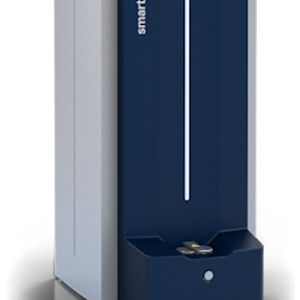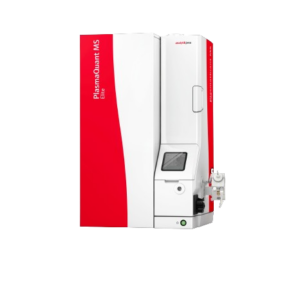timsTOF fleX
The timsTOF fleX is a fully functional high speed, high sensitivity ESI instrument for all your Omics analyses with integrated MALDI source for fast MALDI Imaging
SpatialOMx® Driven ESI/MALDI with Zero Compromises

timsTOF fleX
MALDI Guided SpatialOMx® on the timsTOF fleX
Sensitivity
SpatialOMx® on the timsTOF fleX provides high ID-rates from small samples amounts to combine regiospecificity from MALDI Imaging with PASEF® empowered Omics.
Spatial
resolution
High spatial resolution MALDI source and stage specifically designed for resolving molecular distributions brings a spatial dimension to Omics analyses.
Versatility
The dual source instrument conducts robust ESI measurements and spatially resolves a wide range of molecules directly from tissue using one platform.
timsTOF fleX
microGRID - Accurate and robust high-resolution imaging made simple
High resolution imaging has never been easier. Bruker's microGRID technology combines MALDI stage and smartbeam 3D laser beam positioning to facilitate high quality imaging down to 5 µm spatial resolution.
The optionally available microGRID for all timsTOF fleX instruments is fully integrated into Bruker's established workflows to enable out of the box high spatial resolution imaging. The technology seamlessly integrates in Bruker's fully automated SCiLS™ autopilot workflow, making the technology attractive not only for experts but also for novelists as well as for routine applications.
In combination with SCiLS™ Lab Bruker rounds off the package and delivers a high-performance software to analyze high-resolution imaging data.
Enhanced resolution of rat testis images from 20 µm to 5 µm with microGRID imaging allows to access fine tissue structures of the organ.
microGrid for timsTOF fleX MALDI-2
“Since we work closely with pathologists and people who are used to looking through microscopes, we cannot afford artifactual data in our images, but we also need to cover a large field-of-view. Bruker’s microGRID helps us to effortlessly achieve both without limiting the area of the slide we can process for creating multiomic and multimodal images of diseased and homeostatic pathology.”
Prof. Ron Heeren, M4i - Maastricht Multimodal Molecular Institute, Maastricht University, Maastricht, Netherlands
timsTOF fleX
From 4D-Omics to molecular imaging without stopping, changing, modifying or compromises
Dual source design to match PASEF® empowered LC-MS/MS identification with label-free spatial localization to decode the molecular make up of your sample
Built on the standard for shotgun proteomics, the timsTOF fleX combines best in class 4D-Omics with Bruker’s cutting edge MALDI Imaging technology, including smartbeam 3D laser optics to be a fast measurement all in one platform. A dual source instrument ideal for SpatialOMx®, timsTOF fleX conducts robust ESI measurements and spatially resolves a wide range of molecules directly from tissue using one platform. No single instrument has before provided access to both essential capabilities for the most advanced Omics researchers.
During operation, software activation of the smartbeam 3D laser is the only change in the source region to change from ESI to MALDI in seconds. No complicated changeover means making zero compromises in productivity and the ability to move effortlessly from world class Omics identification and quantification workflows to creating high definition molecular maps of tissue sections to see what matters most.
timsTOF fleX
Dig deeper by adding an additional dimension to your MALDI images
Since ions produced by MALDI and ESI travel the same path to the detector from the source, MALDI workflows can take advantage of the most advanced features found in the timsTOF HT, including trapped ion mobility separation (TIMS) based on the collisional cross section (CCS) of detected molecules. Tuning and calibration can be performed in ESI mode and used for the MALDI experiment for additional ease of optimization.
TIMS allows for the separation of molecules dependent on the shape of the ions. Ions are entering the dual TIMS device together with a gas stream and are accumulated in the first section by an electrical field. The actual separation takes place in the second part of the TIMS cartridge. Ions are eluted in a temporal and spatial fashion by lowering the electrical potential. Variable ramp speed and mobility range adaptation gives rise to optimizations for different classes of molecules allowing high flexibility for the user.
Bring a spatial dimension to Omics analyses
It has never been so easy to combine the regiospecificity of MALDI Imaging with in-depth Omics analyses. Applicable for examining a wide range of analytes, including metabolites, lipids or glycans, and seamlessly compatible with microscopy workflows, MALDI Imaging can identify regionally specific compound distributions for SpatialOMx® analyses. Cutting-edge instrumentation with a dual-source design paired with proofed high purity consumables for robust analyses and user-friendly software saves time and makes your research life easier. Use Bruker’s IntelliSlides® for automated MALDI Imaging and SpatialOMx® workflows on the timsTOF fleX.
Learn more about SpatialOMx Need help with SpatialOMx funding proposals?
H&E stain of a breast cancer section with the histopathological annotation of the tumor region (left side) and overlay with the spatial segmentation result from the MALDI Imaging analysis (right side). Based on the molecular content measured by MALDI Imaging, tumor subtypes can be defined that allow for tissue specific laser microdissection (LMD) and in-depth Omics analysis after MALDI Imaging (image courtesy of Ron Heeren, Maastricht, Netherlands).
timsTOF fleX
Take advantage by separating isobaric or isomeric ions
Isomer separation on the timsTOF fleX
The analyses of complex samples such as tissue sections benefit from trapped ion mobility spectrometry (TIMS). Separate isobaric or isomeric metabolites, lipids, peptides or glycans to get the true spatial localization of your analytes. The timsTOF fleX offers the only chance to differentiate isomeric distributions where high mass resolution fails.
Use the collisional cross section (CCS) as an outcome of TIMS to validate the identity of your analyte with an additional quality criterion. CCS-enabled software intelligently matches spatial MALDI-TIMS Imaging data with Omics results and enables vital morphological context to ID-lists.
timsTOF fleX
Going from the chromatogram to the pixel has never been easier …
The timsTOF fleX is a versatile instrument for probing the molecular content of your sample. Built on Bruker’s pioneering timsTOF HT platform, the timsTOF fleX is a fully functional high speed, high sensitivity ESI instrument for all your Omics analyses, combined with a high spatial resolution MALDI source and stage specifically designed for resolving molecular distributions and bringing a spatial dimension to Omics analyses. Transform proteomics analysis into spatial proteomics, lipidomics into spatial lipidomics, and metabolomics into spatial metabolomics and get tissue context to your data. Interact with other disciplines and get more out of your analytical data to be successful.
SCiLS™ autopilot workflow for Imaging beginners
Our ready-to-run consumables and software products enable you to acquire and interpret molecular tissue images like a seasoned professional. Automated imaging runs built on our advanced IntelliSlides® save time and effort and ensure precise results. Reproducible outcomes are guaranteed with our pure fleXmatrix® provided in pre-measured vials ready for coating. Get access to these consumables and more in Bruker’s webshop.
Converting raw data into statistically treated information and enlightening images is carried out by SCiLS™ Lab, the “gold standard” for mass based molecular imaging. SCiLS™ has also partnered with MetaboScape® for precise image annotation from databases or LC/MS runs. This unique combination powers SpatialOMx® to provide important biological context to your bulk or single-cell Omics work.
Lean more about SCiLS autopilot
Streamlined software workflow SCiLS™ autopilot provides a simple and controlled way to set-up MALDI Imaging measurements for reliable and robust data acquisitions.
timsTOF fleX
Combining Omics performance with high MALDI sensitivity
timsTOF fleX uniquely enables SpatialOMx®
Whether it’s proteomics, lipidomics, glycomics, or metabolomics, the timsTOF fleX is the ideal platform for deep SpatialOMx® analyses. Use patented smartbeam 3D technology to conduct fast, label-free MALDI Imaging for mapping the distribution of molecules in your sample and identify regions of interest for more specific analyses. Apply PASEF® powered LC-MS/MS for the highest level of identifications and for greatest confidence in your results.
A tumor is more than meets the eye
The microenvironment of cancers contains a combination of healthy cells, tumor cells, connective tissue, blood vessels, and inflammation in different ratios at different time points. Each of these components will have their own unique molecular signature of compounds. Researchers who study disease states rely heavily on interpreting tissue pathology and creating these maps within the context of biomolecules bridges the gap between traditional Omics and understanding disease.
Differences in organ functions are reflected in differences in their expressed proteins
timsTOF fleX
Find the difference with CCS-enabled SpatialOMx®
Differentiation of isobaric lipids in a freshwater crustacean sample. Lipids were localized to their tissue origin and identified by in-situ MS/MS or PASEF® empowered 4D-Lipodomics™ on the timsTOF fleX. The sample was kindly provided by Sophie Ayciriex, University of Lyon, Villeurbanne, France.
Cancer cells and other disease states have significant genetic and epigenetic modifications that influence the genomic expression cascade. Whether you are looking at the proteome, lipidome or metabolome, the spatial distribution of compounds contains valuable information for interpretation. Understanding complex samples require unmatched analytical depth provided by the ion mobility option of the timsTOF fleX in addition to mass and charge. Isobaric interferences can be distinguished, and isomers separated. This helps for example to localize isobaric lipids in tissues. In-situ MS/MS as well as PASEF® empowered 4D-Omics provides you with the ability to identify your analytes of interest.
timsTOF fleX
Introducing an automated molecular annotation workflow for SpatialOMx®
Using Bruker’s industry leading software, it is now possible to annotate target molecules directly from tissue. Simply load your data into SCiLS™ Lab, define regions of interest, and export the peak lists to MetaboScape®. Annotate your peaks using databases or compound lists from LC-MS/MS analyses, then review and export your annotations back to SCiLS™ for visualization. From SCiLS™ you can then visualize results with pathways and familiar nomenclature rather than mass labels to reduce the time from data to results.











